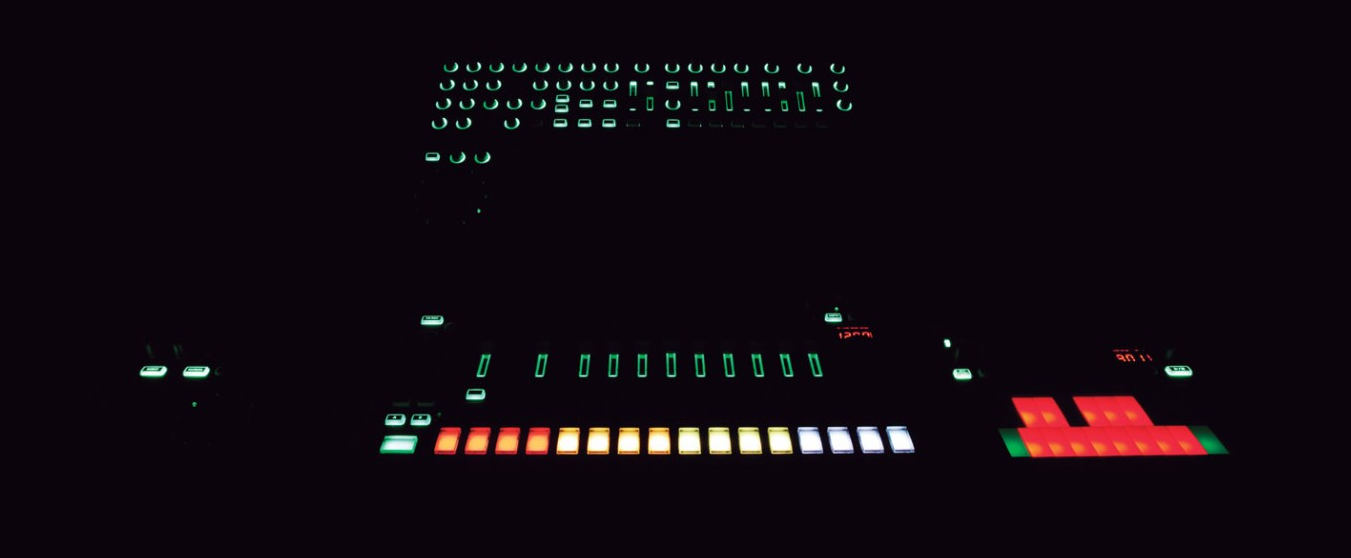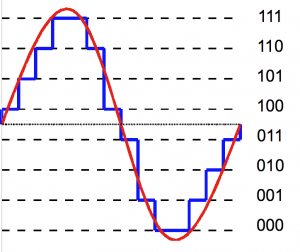Digital Modularity: The Roland System-1M

In the past year synthesizer manufacturers Moog and Korg have released re-issues of their famous analog synthesizer models of the past. Just as many other companies that reacted to the nostalgia surge of the past 15 years, so did Moog and Korg with reissued synthesizes like the Minimoog Voyager, a remake of the ‘71 Minimoog, and the Korg MS20 mini, a smaller version of the ‘78 MS20. A synth manufacturer that seems to go against this nostalgia induced trend is Roland, with it’s latest System-1M semi-modular digital synthesizer. Based of their previous System-1 (no ‘M’), this semi-modular version ditches the keyboard for a so-called ‘patchbay’ where one can patch different aspects of the synthesizer to certain parameters by the use of patch cables, a basic principle of modular synthesis. The thing that makes the System-1M unique is that it’s the first mass-produced synthesizer that includes this type of modularity. One reviewer noted:
“Until recently, Eurorack, the small-scale modular synth format, has been the domain of boutique companies like Doepfer, Make Noise, Mutable Instruments and Pittsburgh Modular. The latest additions to Roland’s AIRA line are aiming to take a cut of this growing market for hand-built patchable synthesizers. […] It’s probably the bravest move any of the big music gear manufacturers have made in years; an attempt to break into a relatively obscure format with products aiming not just at novices, but hardened Eurorack users too.” (Wilson)
What is even more notable is that this synthesizer is completely digital. Modular synthesis has mostly been a world of analog circuitry, not of digital chips and 1’s and 0’s. While there have been many non-modular digital synthesizers (everyone can remember those cheesy 80’s synthpop records or those obviously fake sounding ‘90’s trumpet sounds), digital synthesis is quite new for the modular world. Because of this, the S-1M can be seen as an emergent media object: It traverses the boundaries of the analog and digital worlds of synthesis.
Video demonstrating the System-1M.
Like many photographers looking for ways to recall nostalgia in their photo’s by the means of post-processing (Instagram) or by simply using older gear (Poloraid camera’s), many synthesists look for a certain type of analog/vintage sound in their synthesizers. This type of sound can be emulated by some modern virtual synths, via audio post-processing, or by using real vintage analog synthesizers. The many sites dedicated to analog synthesizers speak volumes on the popularity of analog synthesis, just as the prices of certain analog synthesizers on Ebay. In this obsessive field of retro-nostalgia the S-1M stands out even more; it’s a synthesizer that doesn’t hide its ‘digitalness’.
It may be useful to explain the difference between analog en digital synthesis before continuing. Analog synthesis relies on continuous electronic circuits, which means that the generated sound is continuous. If you zoom in on the waveform of an analog generated sinusoid (a basic sound wave) you would see one continuous curve without major interruptions. Digital synthesis relies on digital microchips that work with discontinuous logic gates, which causes the generated sound to be stepped. If you zoom in on a digitally generated sinewave, you will therefore see small quantization artifacts (Lawson). This difference in sound synthesis can be seen in the image below, with an analog sinusoid in red and a digital sinusoid in blue.
 It’s up for debate whether this difference affects the perceivable sound output (Howard), although a trained listener might hear the differences in their output almost instantly. While analog synthesis is often described as warm and full, digital synthesis is described as clear and bright. Bob Moog, the creator of the Minimoog and pioneer of electronic music, draws a connection between how we experience incandescent light, a warm light source containing a continuous spectrum, different from a fluorescent light, a bright light source with gaps in it’s spectrum (Vail). Whereas incandescent light is expansive to produce and not easy to tune to specific light frequencies (e.g. blue light, instead of white), this is much easier done with fluorescent light. The same can be said for sound synthesis: while analog synthesis is warm, it isn’t as versatile as digital synthesis.
It’s up for debate whether this difference affects the perceivable sound output (Howard), although a trained listener might hear the differences in their output almost instantly. While analog synthesis is often described as warm and full, digital synthesis is described as clear and bright. Bob Moog, the creator of the Minimoog and pioneer of electronic music, draws a connection between how we experience incandescent light, a warm light source containing a continuous spectrum, different from a fluorescent light, a bright light source with gaps in it’s spectrum (Vail). Whereas incandescent light is expansive to produce and not easy to tune to specific light frequencies (e.g. blue light, instead of white), this is much easier done with fluorescent light. The same can be said for sound synthesis: while analog synthesis is warm, it isn’t as versatile as digital synthesis.
Image by WikiMedia.
If Roland’s bravery will pay off in the end is discussion for elsewhere; for now I’d like to get into the emergent aspects of the S-1M itself. First of, the size of the device. Because of its digital nature, it doesn’t need heavy analog circuitry to operate, only digital chips and software. One reviewer notes: “Roland has transformed what is traditionally a large, cumbersome object into something incredibly light and portable,” (Wilson). While not as small as the Korg Volca Line, this kind of portability is new for modular synthesizers. Following the trend of miniaturization that most technologies go through, Roland seems to be one of the first manufacturers to apply this to modular synthesizers.
Second, the S-1M’s patchbay connectivity bridges the gap between analog and digital modular synthesis. While efforts to combine analog and digital synthesis have been numerous, this has mostly been done by layering synthesizers on top of each other or by splicing them together by means of recording (e.g. the famous Forbidden Planet soundtrack by Bebe and Louis Barron, or works by electronica artist Aphex Twin). With the S-1M it is possible to interface digital synthesis methods directly with analog synthesizers, combining best of both worlds and opening up new ways of synthesis.
Soundtrack from the science fiction movie “Forbidden Planet”.
Third, because of its digital nature Roland has been able to include a so-called ‘plugout’ feature with the S-1M. Where traditionally analog modular synthesizers could be expanded indefinitely with new hardware, the S-1M can be expanded upon through new software. With new ‘plugout’ modules, Roland aims to sell new synthesis methods to users of the S-1M, without the need of acquiring new hardware.
Before ending this post, I’d like to briefly couple above three features to their respective debates. Firstly, because of it’s digital nature, the S-1M is a diversion from the ‘re-make’ culture that synthesizer manufacturers seems to have been stuck in. Roland is one of the first major manufacturers to escape from what culture critic and music journalist Simon Reynolds called the “Re-Decade”, a timespan that can arguably be said to be still expanding, wherein everything is revived, remade, remixed or reissued (Reynolds).
Secondly, because the S-1M bridges two types of synthesis, this opens room for discussing where synthesis might be headed. The cybernetic imperative posed that anything might once be synthesized through the use of negative feedback loops (Hayles), and some early synthesists predicted that all sounds might once be generated by analog or digital means (Mathews). Both predictions haven’t come true for sound synthesis because of several reasons, the most difficult being the development of a standarized language to categorize sound (Serra).*
Lastly, with the S-1M’s ‘plugout’ functionality Roland has tapped into the ‘economics of locking-in’. Lock-in is the phenomenon of making customers dependent on a business for it’s products and services by some means of technology (Cowan), something that is done by big companies as Apple, Google and Microsoft. Roland follows this pattern, by not permitting ‘plugout’ modules to be created or modified by users. Users wanting extended functionality are therefore dependent on the Roland Content ecosystem, which is solely maintained by the company for profit. Users may become dependent of this system, something that may serve Roland’s interests more than that of it’s users.
*While sampling techniques come pretty close to imitating the real, the synthesis of real world sounds still has a long way to go.
References
Cowan, Robin. “Tortoises and Hares: Choice Among Technologies of Unknown Merit.” The Economic Journal 101.407 (1991): 801–814. JSTOR. Web. 13 Sept. 2015. Print.
Hayles, N. Katherine. “Boundary Disputes: Homeostasis, Reflexivity, and the Foundations of Cybernetics.” Configurations 2.3 (1994): 441–467. Print.
Howard, Keith. “Euphonic Distortion: Naughty but Nice?” Stereophile 30 June 2006. Web.
Lawson, Nate. “Why Digital Logic Is Different than Analog.” root labs rdist. Web. 13 Sept. 2015.
Mathews, Max V. “The Digital Computer as a Musical Instrument.” Science 142.3592 (1963): 553–557. Print.
Reynolds, Simon. Retromania: Pop Culture’s Addiction to Its Own Past. Reprint edition. London ; New York: Faber & Faber, 2011. Print.
Serra, Xavier. “Current Perspectives in the Digital Synthesis of Musical Sounds.” Formats 1 (1997). Print.
Vail, Mark. “A Conversation With Bob Moog: Analog vs Digital Sound Generation.” Keyboard Magazine 1 Jan. 2005. Web.
Wilson, Scott. “Roland AIRA Modular: Eurorack’s Gateway Drug.” FACT Magazine: Music News, New Music. Web. 13 Sept. 2015. Web.